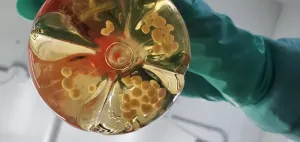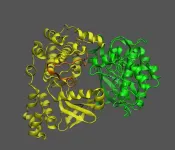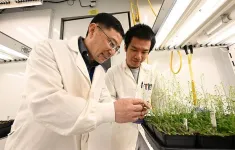(Press-News.org) Key Takeaways
Immune thrombotic thrombocytopenic purpura, a rare blood clotting disorder, results from an autoimmune attack against an enzyme called ADAMTS13
A recombinant form of human ADAMTS13 approved for a different condition helped to save the life of a young mother with immune thrombotic thrombocytopenic purpura
Results from this first use of the drug for this condition—by a team led by researchers from Massachusetts General Hospital—warrants testing the drug in a clinical trial
A team led by investigators from Massachusetts General Hospital, a founding member of the Mass General Brigham healthcare system, used a new drug to save the life of a patient with immune thrombotic thrombocytopenic purpura (iTTP), a rare disorder characterized by uncontrolled clotting throughout the small blood vessels. The group describes the first clinical use of the drug for iTTP in the New England Journal of Medicine.
“The drug is a genetically engineered version of the missing enzyme in iTTP, and we showed that it was able to reverse the disease process in a patient with an extremely severe form of this condition,” said lead author Pavan K. Bendapudi, MD, an investigator in the Division of Hematology and Blood Transfusion Service at Massachusetts General Hospital and an assistant professor of Medicine at Harvard Medical School.
iTTP results from an autoimmune attack against an enzyme called ADAMTS13 that is responsible for cleaving a large protein involved in blood clotting. The current mainstay of therapy for this life-threatening blood disorder is plasma exchange, which removes the harmful autoantibodies and provides extra ADAMTS13. Plasma exchange induces a clinical response in most patients but can restore at best only about half of normal ADAMTS13 activity. By contrast, a recombinant form of human ADAMTS13 (rADAMTS13) offers the possibility of greatly increased ADAMTS13 delivery.
rADAMTS13 was recently approved for patients with congenital thrombotic thrombocytopenic purpura, which occurs in patients born with complete loss of the ADAMTS13 gene. It's questionable whether rADAMTS13 could be effective in iTTP given the presence of inhibitory anti-ADAMTS13 autoantibodies, but Bendapudi and his colleagues received permission from the US Food and Drug Administration to utilize rADAMTS13 donated from the manufacturer under a compassionate use protocol in a dying patient with treatment-resistant iTTP.
“We found that rADAMTS13 rapidly reversed this patient’s disease process despite the current dogma that inhibitory autoantibodies against ADAMTS13 would render the drug useless in this condition,” said Bendapudi. “We were the first physicians to use rADAMTS13 to treat iTTP in the United States, and in this case it helped to save the life of a young mother.”
Bendapudi noted that the infused rADAMTS13 overwhelmed the inhibitory autoantibodies in the patient and reversed the thrombotic effects of iTTP. This impact was observed almost immediately upon administration of rADAMTS13, after daily plasma exchange had failed to induce remission.
“I think rADAMTS13 has the potential to replace the current standard of care in acute iTTP. We will need larger, well-designed trials to evaluate this possibility,” said Bendapudi.
A phase 2b randomized clinical trial of rADAMTS13 in iTTP was recently initiated.
Authorship:
Pavan K. Bendapudi, Brody H. Foy, Sarah B. Mueller, Jun Liu, Louis M. Feingold, Kristen E. Burke, Wendy Cruz, Maria Y. Chen, Emily S. Lau, Rachel L. Goldberg, Ishan Tatake, Shelby C. Wilkinson, Brian J. Carney, James R. Stone, Doyun Park, Alzira Rocheteau Monteiro Avelino, Sajjad Hassan, Chester Andrzejewski, Kristen N. Ruby, Kenneth D. Friedman, Patricia A.R. Brunker, Rebecca K. Leaf, John Higgins, Walter H. Dzik, Jonathan A. Stefely, and Robert S. Makar.
Funding:
Research support was provided by the National Institutes of Health and the Luick Family Fund of the Department of Pathology at Massachusetts General Hospital.
Paper cited:
Bendapudi, P. K., Foy, B. H., Mueller, S. B., Liu, J., Feingold, L. M., Burke, K. E., Cruz, W., Chen, M. Y., Lau, E. S., Goldberg, R. L., Tatake, I., Wilkinson, S. C., Carney, B. J., Stone, J. R., Park, D., Avelino, A. R., Hassan, S., Andrzejewski, C., Ruby, K. N., Friedman, K. D., … Makar, R. S. (2024). Recombinant ADAMTS13 for Immune Thrombotic Thrombocytopenic Purpura. The New England journal of medicine, 390(18), 1690–1698. https://doi.org/10.1056/NEJMoa2402567
END
Clinicians report success with first test of drug in a patient with life-threatening blood clotting disorder
Results from this first use of the drug for this condition—by a team led by researchers from Massachusetts General Hospital—warrants testing the drug in a clinical trial
2024-05-17
ELSE PRESS RELEASES FROM THIS DATE:
NIH study shows chronic wasting disease unlikely to move from animals to people
2024-05-17
WHAT:
A new study of prion diseases, using a human cerebral organoid model, suggests there is a substantial species barrier preventing transmission of chronic wasting disease (CWD) from cervids—deer, elk and moose—to people. The findings, from National Institutes of Health scientists and published in Emerging Infectious Diseases, are consistent with decades of similar research in animal models at the NIH’s National Institute of Allergy and Infectious Diseases (NIAID).
Prion diseases are degenerative diseases found in some mammals. These diseases primarily involve deterioration of the brain but also can affect the eyes and other organs. ...
Scientists discover mechanism of sugar signaling in plants
2024-05-17
UPTON, N.Y. — Proteins are molecular machines, with flexible pieces and moving parts. Understanding how these parts move helps scientists unravel the function a protein plays in living things — and potentially how to change its effects. Biochemists at the U.S. Department of Energy’s (DOE) Brookhaven National Laboratory and colleagues at DOE’s Pacific Northwest National Laboratory (PNNL) have just published a new example of how one such molecular machine works.
Their paper in the journal Science Advances describes how the moving parts of ...
Cleveland Clinic research finds VISTA directly blocks T-cells from functioning in immunotherapy
2024-05-17
A Cleveland Clinic-led team of scientists and physicians have discovered that the immune checkpoint protein VISTA can directly turn off tumor-fighting T-cells during immunotherapy and resist treatment.
The study, published in Science Immunology, explains that VISTA can bind to a protein called LRIG1 in T cells, which was previously only thought to promote bone and fat development. When VISTA binds to LRIG1, the researchers found, LRIG1 sends signals that suppress T cell replication, survival ...
Pagan-Christian trade networks supplied horses from overseas for the last horse sacrifices in Europe
2024-05-17
Horses crossed the Baltic Sea in ships during the Late Viking Age and were sacrificed for funeral rituals, according to research from Cardiff University.
Published in the journal Science Advances, studies on the remains of horses found at ancient burial sites in Russia and Lithuania show that they were brought overseas from Scandinavia utilising expansive trade networks connecting the Viking world with the Byzantine and Arab Empires.
Up to now, researchers had believed sacrificial horses were always locally-sourced stallions. ...
University of Bristol researchers develop world’s smallest quantum light detector on a silicon chip
2024-05-17
Researchers at the University of Bristol have made an important breakthrough in scaling quantum technology by integrating the world’s tiniest quantum light detector onto a silicon chip.
A critical moment in unlocking the information age was when scientists and engineers were first able to miniaturise transistors onto cheap micro-chips in the 1960s.
Now, for the first time, University of Bristol academics have demonstrated the integration of a quantum light detector – smaller than a human hair – onto a silicon chip, moving us one step closer to the age of quantum technologies using light.
Making high performance electronics ...
Gut bacteria boost immune response to fight tumors
2024-05-17
Roughly one in five cancer patients benefits from immunotherapy – a treatment that harnesses the immune system to fight cancer. Such an approach to beating cancer has seen significant success in lung cancer and melanoma, among others. Optimistic about its potential, researchers are exploring strategies to improve immunotherapy for cancers that don’t respond well to the treatment, with the hope of benefiting more patients.
Now, researchers at Washington University School of Medicine in St. Louis have found, in ...
How heatwaves are affecting Arctic phytoplankton
2024-05-17
The basis of the marine food web in the Arctic, the phytoplankton, responds to heatwaves much differently than to constantly elevated temperatures. This has been found by the first targeted experiments on the topic, which were recently conducted at the Alfred Wegener Institute’s AWIPEV Station. The phytoplankton’s behaviour primarily depends on the cooling phases after or between heatwaves, as shown in a study just released in the journal Science Advances.
Heatwaves, which we’ve increasingly seen around the globe in recent years, are also becoming more and ...
NUS scientist Professor Lim Chwee Teck elected Fellow of the Royal Society
2024-05-17
Professor LIM Chwee Teck, Director of the Institute for Health Innovation & Technology at the National University of Singapore (NUS iHealthtech) and NUSS Professor, has been elected to the prestigious Fellowship of the Royal Society, in recognition of his invaluable contributions to science.
The Royal Society is the world's oldest and most esteemed scientific academy in continuous existence, as well as the United Kingdom’s national academy of sciences. Fellows are elected annually, and candidates are evaluated based on their exceptional achievements in science. This ...
Modern plant enzyme partners with surprisingly ancient protein
2024-05-17
UPTON, N.Y. — Scientists from the U.S. Department of Energy’s (DOE) Brookhaven National Laboratory have discovered that a protein responsible for the synthesis of a key plant material evolved much earlier than suspected. This new research explored the origin and evolution of the biochemical machinery that builds lignin, a structural component of plant cell walls with significant impacts on the clean energy industry.
When the first land plants emerged from aquatic environments, they needed to adapt in order to survive.
Chang-Jun Liu, a senior scientist in Brookhaven’s Biology ...
Ion irradiation offers promise for 2D material probing
2024-05-17
Two-dimensional materials such as graphene promise to form the basis of incredibly small and fast technologies, but this requires a detailed understanding of their electronic properties. New research demonstrates that fast electronic processes can be probed by irradiating the materials with ions first.
A collaboration involving researchers at the University of Illinois Urbana-Champaign and the University of Duisburg-Essen has shown that when graphene is irradiated with ions, or electrically charged atoms, the electrons that are ejected ...
LAST 30 PRESS RELEASES:
Mount Sinai Health system receives $8.5 million NIH grant renewal to advance research on long-term outcomes in children with congenital heart disease
Researchers develop treatment for advanced prostate cancer that could eliminate severe side effects
Keck Medicine of USC names Christian Pass chief financial officer
Inflatable fabric robotic arm picks apples
MD Anderson and SOPHiA GENETICS announce strategic collaboration to accelerate AI-driven precision oncology
Oil residues can travel over 5,000 miles on ocean debris, study finds
Korea University researchers discover that cholesterol-lowering drug can overcome chemotherapy resistance in triple-negative breast cancer
Ushikuvirus: A newly discovered giant virus may offer clues to the origin of life
Boosting the cell’s own cleanup
Movement matters: Light activity led to better survival in diabetes, heart, kidney disease
Method developed to identify best treatment combinations for glioblastoma based on unique cellular targets
Self-guided behavioral app helps children with epilepsy sleep earlier
Higher consumption of food preservatives is associated with an increased risk of type 2 diabetes
NTU Singapore-led team captures first-ever ‘twitch’ of the eye’s night-vision cells as they detect light, paving the way for earlier detection of blindness-causing diseases
Global aviation emissions could be halved through maximising efficiency gains, new study shows
Fewer layovers, better-connected airports, more firm growth
Exposure to natural light improves metabolic health
As we age, immune cells protect the spinal cord
New expert guidance urges caution before surgery for patients with treatment-resistant constipation
Solar hydrogen can now be produced efficiently without the scarce metal platinum
Sleeping in on weekends may help boost teens’ mental health
Study: Teens use cellphones for an hour a day at school
After more than two years of war, Palestinian children are hungry, denied education and “like the living dead”
The untold story of life with Prader-Willi syndrome - according to the siblings who live it
How the parasite that ‘gave up sex’ found more hosts – and why its victory won’t last
When is it time to jump? The boiling frog problem of AI use in physics education
Twitter data reveals partisan divide in understanding why pollen season's getting worse
AI is quick but risky for updating old software
Revolutionizing biosecurity: new multi-omics framework to transform invasive species management
From ancient herb to modern medicine: new review unveils the multi-targeted healing potential of Borago officinalis
[Press-News.org] Clinicians report success with first test of drug in a patient with life-threatening blood clotting disorderResults from this first use of the drug for this condition—by a team led by researchers from Massachusetts General Hospital—warrants testing the drug in a clinical trial






